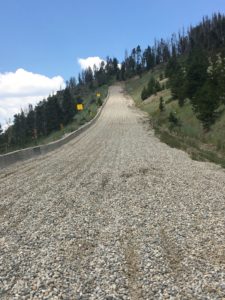
Anyone who has driven through the I-70 mountain corridor a few times knows about runaway truck ramps. Anyone who drives over with regularity has certainly smelled, or perhaps even seen, the smoke coming off overheated brakes on rigs and other vehicles.
There are five ramps on Colorado’s stretch of I-70 and thirteen throughout the state, but studies show that a significant portion of vehicles in need of the ramps don’t actually use them.
Kelly Strong, an associate professor in CSU’s Department of Construction Management, is working on a proposal for the Colorado Department of Transportation that could alter how these ramps are used and maintained.
According to Strong, the most common reason drivers fail to use the ramps is inexperience. The Rocky Mountains provide a specific terrain filled with steep grades and sharp turns that even natives can have trouble navigating. For those unfamiliar with the terrain or their vehicle, it can be difficult to tell if and when they’re getting into trouble, causing many drivers to continue driving with compromised brakes.

“A few RVs end up in the truck ramp every year,” said Strong, citing this unfamiliarity as the same problem many truckers who are not accustomed to driving in the Rockies will experience.
“Drivers who have this as part of their normal route know how to work their gears so that the trucks are in control, but when they aren’t experienced mountain drivers, they frequently don’t know they’re in trouble until it’s too late.”
There’s also a reduced likelihood of even experienced rig drivers using the ramps because of the possibility that their cargo could be compromised when using the ramp. Perhaps because of this possibility, many trucking companies issue citations to drivers who do use ramps, which further discourages use for drivers who might be apprehensive of getting in trouble with their companies.
This ramp related cargo loss is not abnormal, but it’s also not a forgone conclusion. It’s often caused when the tractor (the truck part of a rig) and trailer decelerate at different rates, or when the rig slows down too abruptly. Both of these can be caused when the material used in truck ramps, called pea gravel, moves out of place so that it is unevenly distributed on a slope or even falls away altogether.
Strong’s team is attempting to provide a variety of solutions to the runaway truck ramps’ problems. Their recommendations to CDOT focus on the upper and lower Straight Creek ramps near Eisenhower Tunnel. These two ramps are used approximately once a week, and statistics indicate they account for as much as 90 percent of all truck ramp use in the I-70 mountain corridor.

The key points in Strong and his team’s plan include maintenance, renovation, and education. One of their key concerns is the material falling over the sides and down the hills these truck ramps are built into. They hope to develop a better maintenance program to help the material stay in place longer.
Unfortunately, they not only have to combat the force of gravity but also the weather. In Colorado, the intense variation between summer heat and winter snowfall can cause rocks to compact or mix with unwanted sediments. This makes it difficult to maintain a uniform and appropriately lenient material on the ramp. An alteration in the composition of gravel used in the ramps could help both the position and consistency of the material.
None of this matters if they can’t get drivers to use the ramps though. Strong’s team is considering ways to improve signage so that drivers are more aware of truck ramps that are coming up, as well as an education program for rig drivers. This program would hopefully help drivers who are unfamiliar with the mountains understand ways to better handle their vehicles and when it is necessary to pull off for a ramp.

Although Strong’s team has not yet submitted the proposal to CDOT, they are hopeful that these changes will create safer driving conditions for Rocky Mountain travelers.
Other researchers on Strong’s team include Scott Shuler and Rodolfo Valdes-Vasquez.
The Department of Construction Management is part of CSU’s College of Health and Human Sciences.